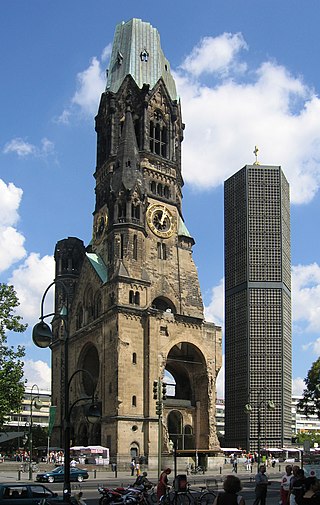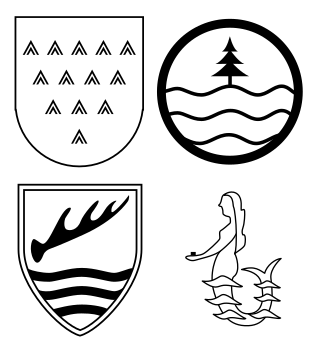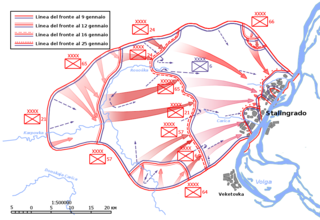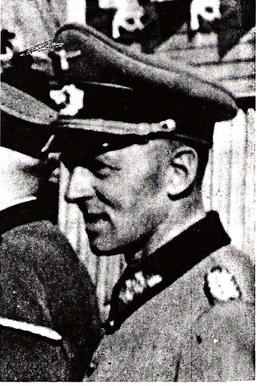
The Battle of Stalingrad was a major battle on the Eastern Front of World War II where Nazi Germany and its allies unsuccessfully fought the Soviet Union for control of the city of Stalingrad in Southern Russia. The battle was marked by fierce close-quarters combat and direct assaults on civilians in air raids, with the battle epitomizing urban warfare. It was the bloodiest battle of the Second World War, with both sides suffering enormous casualties. Today, the Battle of Stalingrad is often regarded as the turning point in the European theatre of war, as it forced the Oberkommando der Wehrmacht to withdraw considerable military forces from other areas in occupied Europe to replace German losses on the Eastern Front, ending with the rout of the six field armies of Army Group B, including the destruction of Nazi Germany's 6th Army and an entire corps of its 4th Panzer Army. The Soviet victory energized the Red Army and shifted the balance of power in the favour of the Soviets.

Volgograd, formerly Tsaritsyn (1589–1925), and Stalingrad (1925–1961), is the largest city and the administrative centre of Volgograd Oblast, Russia. The city lies on the western bank of the Volga, covering an area of 859.4 square kilometres, with a population of slightly over one million residents. Volgograd is the sixteenth-largest city by population size in Russia, the second-largest city of the Southern Federal District, and the fourth-largest city on the Volga.

The Cathedral Church of Saint Michael, commonly known as Coventry Cathedral, is the seat of the Bishop of Coventry and the Diocese of Coventry within the Church of England. The cathedral is located in Coventry, West Midlands, England. The current bishop is Christopher Cocksworth and the current dean is John Witcombe.
During World War II, the German military planned or undertook an operation named Donnerschlag.

The Kaiser Wilhelm Memorial Church is a Protestant church affiliated with the Evangelical Church in Berlin, Brandenburg and Silesian Upper Lusatia, a regional body of the Protestant Church in Germany. It is located in Berlin on the Kurfürstendamm in the centre of the Breitscheidplatz.

Mamayev Kurgan is a dominant height overlooking the city of Volgograd in Southern Russia. The name in Russian means "tumulus of Mamai". The formation is dominated by a memorial complex commemorating the Battle of Stalingrad. The battle, a hard-fought Soviet victory over Axis forces on the Eastern Front of World War II, turned into one of the bloodiest battles in human history. At the time of its installation in 1967 the statue, named The Motherland Calls, formed the largest free-standing sculpture in the world; today it is the tallest sculpture of a woman in the world.

A pocket is a group of combat forces that have been isolated by opposing forces from their logistical base and other friendly forces. In mobile warfare, such as blitzkrieg, salients were more likely to be cut off into pockets, which became the focus of battles of annihilation.

Führerhauptquartier Werwolf was the codename used for one of Adolf Hitler's World War II Eastern Front military headquarters located in a pine forest about 12 kilometres north of Vinnytsia, in Ukraine, which was used between 1942 and 1943. It was one of a number of Führer Headquarters throughout Europe, and the most easterly ever used by Hitler in person.
Sasha Filippov was a spy for the Red Army during the Battle of Stalingrad.

The 305th Infantry Division was a German Army unit that saw extensive, front-line action during World War II. This division was present at the Battle of Stalingrad, the Battle of Monte Cassino, and surrendered to U.S. Army's 88th Infantry Division in Northern Italy near Trento in late April 1945.
The 79th Infantry Division(79. Infanterie-Division) was an infantry division of Nazi Germany's Wehrmacht during World War II.

Operation Koltso was the last part of the Battle of Stalingrad. It resulted in the capitulation of the remaining Axis forces encircled in the city.

A Coventry Cross of Nails is a Christian cross made from iron nails, employed as a symbol of peace and reconciliation. The original version was made from three large medieval nails salvaged from the Coventry Cathedral after the building was severely damaged by German bombs on 14 November 1940, during the Second World War. In the following decades, several hundred crosses have been given as gifts to various organisations, including churches, prisons and schools. The form of the cross echoes the crucifixion of Christ, and the nails with which Christ was affixed to the cross according to some accounts.
The Pitomnik airfield was an airfield in Russia. During the Second World War, it was the primary of seven airfields used by the German Wehrmacht during the Battle of Stalingrad.
The Tatsinskaya Airfield was the main airfield used by the German Wehrmacht during the Battle of Stalingrad to supply the encircled 6th Army from outside.
Major Nikolay Dmitrevich Dyatlenko was a Soviet officer, interrogator and translator who was part of a team that attempted to deliver a message of truce to the German Sixth Army at the Battle of Stalingrad in January 1943. He also acted as the translator at the interrogation of Field Marshal Friedrich Paulus a few weeks later.

Arthur Schmidt was an officer in the German military from 1914 to 1943. He attained the rank of Generalleutnant during World War II, and is best known for his role as the Sixth Army's chief of staff in the Battle of Stalingrad in 1942–43, during the final stages of which he became its de facto commander, playing a large role in executing Hitler's order that it stand firm despite being encircled by the Red Army. He was a prisoner of war in the Soviet Union for twelve years, and was released following West German chancellor Konrad Adenauer's visit to Moscow in 1955.
Rudolf Weiß was a German officer appointed personal adjutant for the Army's Personnel Department Chief, a position he held until the end of World War II. Further, he was stationed in the Führerbunker in April 1945.
The 9th Flak Division was a Flak division of the German Luftwaffe in World War II which saw action on the Eastern Front. It is most notable for its role in the Battle of Stalingrad. Another formation with the same name was deployed to the Eastern Front and saw combat in the Kuban bridgehead.

Leonty Nikolayevich Gurtyev was a Soviet military officer, known for his participation in the Second World War's Eastern front and most notably in the battle of Stalingrad.













